Marianist Vision and Spirit
Marianist Vision and Spirit
– Father Johann Roten, S.M.
This series of bas-reliefs represents facets of the Marianist vision and spirit. They are the work of Spanish artist Antonio de Oteiza, Capuchin. These ceramic sculptures were commissioned by Spanish Marianists to commemorate the September 3, 2000, beatification of Father William Joseph Chaminade (1761-1850), founder of the Marianist Family. Chaminade’s spirit, and that of the Marianist Family, is the “Spirit of Mary.” The “Spirit of Mary” is no mere devotion, but a style of life and a program of action. It is steeped in scripture, and takes as model the person and story of Mary, Mother of Jesus Christ. Oteiza’s ceramics highlight those events of Mary’s life which are the source of inspiration for the Marianist vision and spirit.
Why Vision and Spirit?
Vision is important. Vision only will be able to bring together past, present, and future. Vision unites people and makes them strong. Vision generates dynamism. The Marianist tradition is grounded in a vision. It is a vision of faith in God and people, the never ending hope for a better world, and its transformation into the Kingdom of God. In short, it is a vision of eternity in time to prepare the fullness of time.
No vision survives without the Spirit. The Spirit is grace, the help that comes from the Word of God. The Spirit is the Spirit of Christ, His redeeming and sanctifying grace. In a special way for Marianists the Spirit is the Spirit of Mary: the example of her life, the challenge of her mission, and the sanctity of her person. She is not only the spiritus rector of our vision, she is also the special grace that keeps the vision alive, and makes it ever new.
There are many ways to express the coming together of vision and spirit in the Marianist tradition. A Spanish artist gave it a visual expression.
The pieces:
Open to the Spirit
A Holy Dynamism
“Do Whatever He Tells You”
Behold Your Son
John's Home
A Common Bond
The Three O’Clock Prayer
The Marianist Cross
She Will Crush Your Head
Open to the Spirit
(Luke 1:26-38)
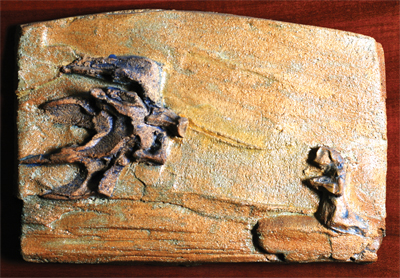
The whirlwind of God’s spirit finds Mary sensitive and open to the “Good News” of the Incarnation. Mary’s disposition at the Annunciation is one of discernment followed by a firm commitment. Her participation in God’s plan of salvation is a joyful (Magnificat) and total dedication (Servant of the Lord) to the “Spirit of Re-creation.”
The disposition of Mary is the basis for Chaminade’s spiritual method. Chaminade taught his disciples the importance of silence: silence of words, of signs, of the imagination, of the mind and of the passions. Here is the reason why the artist called this bas-relief, “The Annunciation of the Silences.” Chaminade’s silence is a silence of pondering and maturing the presence of God in mind and heart.
A Holy Dynamism
(Luke 1:26-38; John 19:26-27)
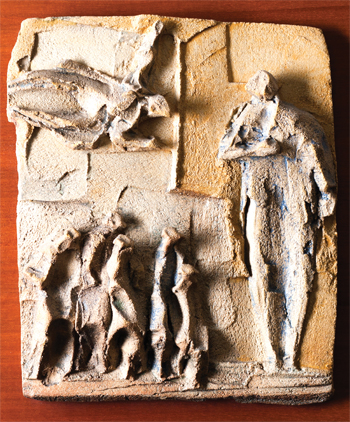
The Annunciation is the beginning of God’s plan of salvation. Thus, the Incarnation achieves its full meaning only in Christ’s passion, death, and resurrection. Nazareth and Calvary, Mary’s “yes” at the Annunciation and at the foot of the cross, are intimately linked. At the moment Mary responded, “let it be done to me according to your word,” she became engaged in the whole of God’s design to recreate creation in his Son.
The Annunciation is the beginning of a holy dynamism which makes of Mary the first disciple of her Son, and the mother of His brothers and sisters. Mary’s posture in the sculpture is erect, confident, and full of holy dynamism. The people in the lower left corner are the sons and daughters she will lead to her Son.
“Do Whatever He Tells You”
(John 2:5)
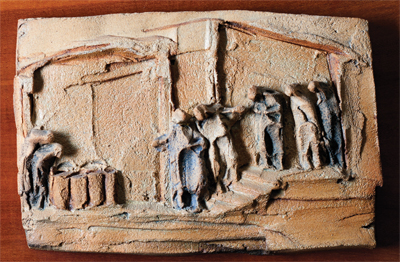
These words pronounced by Mary at the wedding feast at Cana were addressed to the servers when the wine ran short, and Jesus seemed less than concerned by the predicament of the newlyweds. Mary’s words speak of patience and perseverance, of hope and joyful commitment. Mary’s word is a word of confident faith. Chaminade uses this same expression, one of confident faith, to designate the vision and scope of the Marianist apostolic mission. What should the members of the Marianist Family do to further the Kingdom of God? The answer is, “Do whatever he tells us.” Mary’s posture and gesture speak of intense determination. She will always be a mediator.
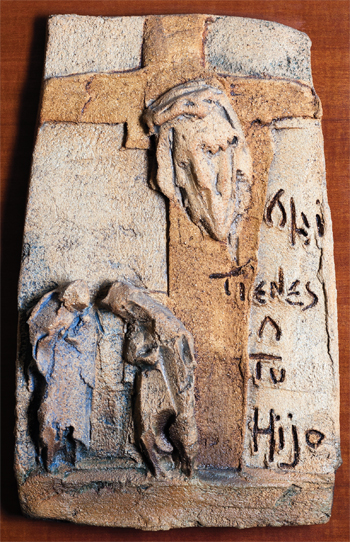
Standing at the foot of the cross are the tiny broken figures of Mary and the beloved disciple. The face of Christ is formless. Pain and disfigurement are excruciating. At this truly crucial moment, Jesus entrusts the beloved disciple to His mother. With this gesture He inaugurated the Church, His Church and followers.
Now Christ’s work is accomplished, but it needs to be announced and made visible by His disciples. Mary plays the role of the mother who points the way to her Son, and opens the heart of the disciple to the Spirit of her Son. Chaminade was convinced that we need to be formed by Mary in the Spirit of her Son.
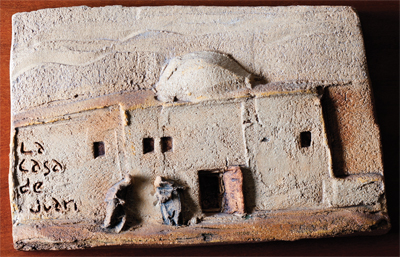
La Casa de Juan or John’s Home represents the answer of the beloved disciple. We read in John 19:27, “…from that hour the disciple took her into his home.” The symbol of the home stands for the disciple’s heart. Mary becomes an intimate part of John’s life.
For Chaminade, and many other spiritual writers, the beloved disciple represents all future disciples of Christ, men and women. Church is truly Church only if she adopts Mary’s faith, hope, and charity. In the words of Blessed William Joseph, “Jesus confided to Mary our Christian formation.”
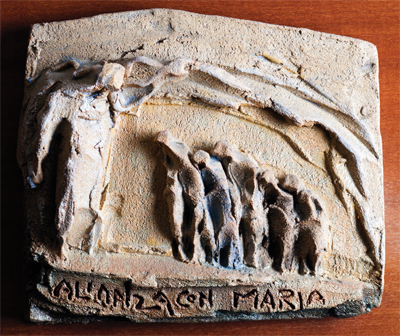
The “Spirit of Mary” is more than lofty thoughts and pious sentiments. It has practical consequences and leads to what Chaminade called the “Alliance with Mary” (“Alianza con Maria”). The expression stands for our common bond with Mary. In this pact of solidarity, Mary is giving us protection and guidance, but our alliance with Mary is foremost a common mission, the active commitment to the mission and work of Jesus Christ. Chaminade calls upon his followers to entrust their lives to Mary and her mission; for Chaminade, Marianists are missionaries of Mary.
The artist rendered the alliance with Mary with a triple symbolism. The gesture of Mary’s outstretched arm suggests both a mantle and a banner. We find protection under Mary’s mantle, but the mantle is also a banner inviting active involvement in her mission. Finally, the monumental figure of Mary symbolizes strength, force of attraction, and the fact that she is a spiritual model for us.
The Three O’Clock Prayer
(John 19:27-30)
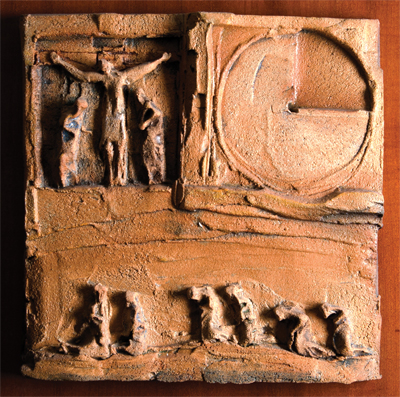
The upper half of the bas-relief establishes the connection between the Three O’Clock Prayer and the crucifixion scene. The huddled figures on the lower half represent Mary and St. John, and all those who “gathered in spirit at the foot of the cross” to commemorate Christ’s death.
The Three O’Clock Prayer is a verbal icon of the Marianist spirit. Simple and unassuming as may be, this prayer not only captures the deepest memories of the Christian faith, but it also conveys the particular spirit that continues to inspire the members of the Family of Mary. It recalls the death of Jesus Christ as it is rendered in John 19:27-30. Daily the Marianists pause at 3:00 p.m. to recall their alliance with Jesus and Mary. We renew our dedication with this prayer:
Lord Jesus, we gather in spirit at the foot of the
cross with your Mother and the disciple whom
you loved.
We ask your pardon for our sins, which are the
cause of your death.
We thank you for having thought of us in that
hour of salvation and for giving us Mary as our
Mother.
Holy Virgin, take us under your protection and
open us to the action of the Holy Spirit.
St. John, obtain for us the grace of taking Mary into
our lives as you did, and of assisting her in her mission.
May the Father and the Son and the Holy Spirit be
glorified in all places through the Immaculate Virgin
Mary.
The Marianist Cross
(John 2:5; 19:27)
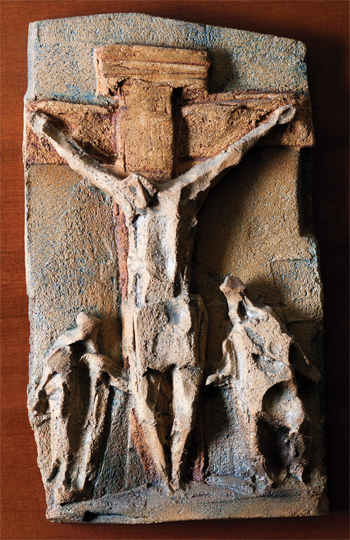
The crucifixion scene with Mary and John visualizes once more the essential aspects of the Marianist spirit. The Marianist cross is a cross promising life, the life that comes to us in Jesus Christ, Son of God and Redeemer. The Marianist cross is also a Marian cross. It represents the embodiment of Chaminade’s vision for the Marianist Family: “Our work is great; it is magnificent. If it is universal, it is because we are missionaries of Mary, who says to us, ‘Do whatever he tells you.’” Chaminade wanted us to realize that “each of us has been called by the Holy Virgin to work for the salvation of all people.”
She Will Crush Your Head
(Genesis 3:15)
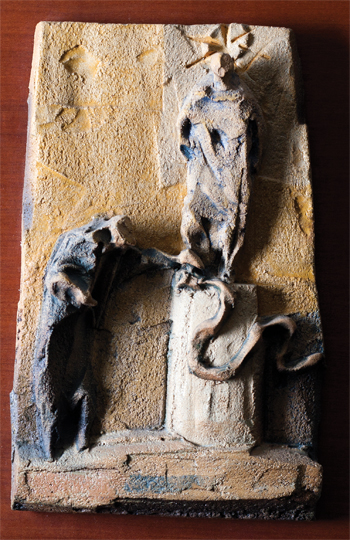
Oteiza’s ceramics end with the reference to Genesis 3:15 in its traditional reading: “She will crush your head.” Mary symbolizes in her person the victory of good over evil. In the end, the faithful will be vindicated just as Mary has reached fulfillment in heaven. Mary stands for final restoration and eternal happiness.
To a novice at Bordeaux Chaminade explained, “All ages of the Church have witnessed the struggles and the glorious triumphs of Mary in enmity with Satan. Mary has been victorious.” Later he counseled, “Remain steadfast in faith. The devil is powerless against a person of faith.”
The figure standing in front of the image of Our Lady, crushing the head of the snake, puts his or her hand on the foot of Our Lady. The figure may be Blessed William Joseph Chaminade or any other person living in the “Spirit of Mary.” The gesture signifies the pledge of those who entrust their lives to the work of Jesus and Mary.
All About Mary includes a variety of content, much of which reflects the expertise, interpretations and opinions of the individual authors and not necessarily of the Marian Library or the University of Dayton. Please share feedback or suggestions with marianlibrary@udayton.edu.
